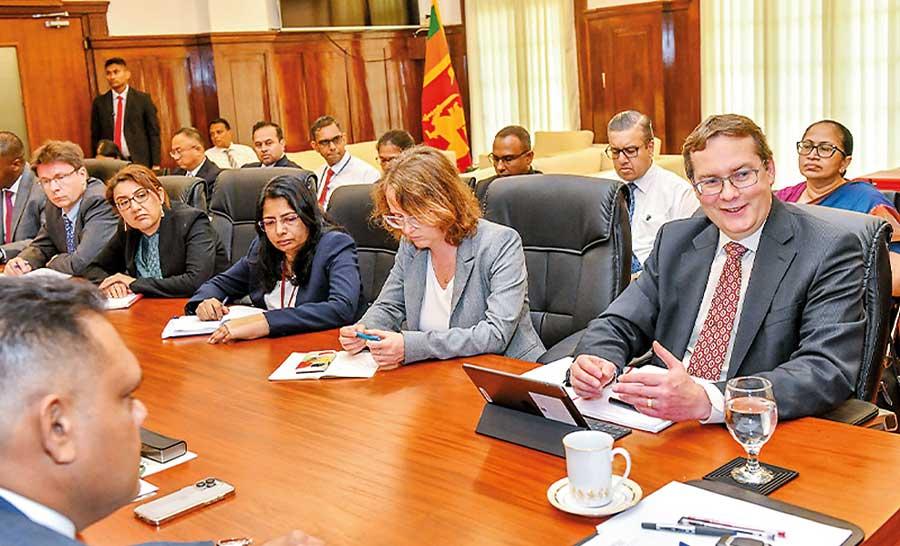Reply To:
Name - Reply Comment

While it is no secret that bondholders like loan sharks will extract what they can from a vulnerable country, what is less known is the role of the IMF in facilitating such extraction
The Finance Ministry is covering up a sweet deal for the international bondholders to the detriment of the country’s long-term financial interests. This is a sign that this government needs to go. The worrying question is whether an extractive debt restructuring deal for the bondholders will be rushed through by this illegitimate government ahead of the elections. This bad deal with some of the most predatory financiers is framed within a creditor-focused IMF programme, which is causing tremendous suffering to our people now and is bound to affect future generations.
long-term financial interests. This is a sign that this government needs to go. The worrying question is whether an extractive debt restructuring deal for the bondholders will be rushed through by this illegitimate government ahead of the elections. This bad deal with some of the most predatory financiers is framed within a creditor-focused IMF programme, which is causing tremendous suffering to our people now and is bound to affect future generations.
In this column, I address the manner in which the current government is selling out the country’s economic future to please its external creditors and to make a political claim before elections that it has brought the country out of bankruptcy. Furthermore, it is not just a bad deal with these atrocious bondholders that is the problem, but rather, the IMF’s framing of debt restructuring and its economic program that inevitably lead to such bad deals, and worse, future cycles of debt distress and economic crises.
Cover up
Sri Lanka’s Central Bank and Finance Ministry have become spin masters for the bondholders. In late June 2023, the Central Bank claimed it would demand a 30% haircut from international bondholders and justified Domestic Debt Restructuring (DDR).
Sri Lanka did not default on its domestic debt and only its foreign debt, but it was pressure from bondholders as a negotiating tactic to reduce their haircut, and the IMF’s framing of combining domestic and external debt, which led to DDR. Worse, DDR was imposed only on the retirement funds of working people including garment and estate workers, while the treasury bonds held by banks, finance companies and wealthy individual investors were not touched.
Where Sri Lanka stood last year, and the criticism of the debt restructuring process then, was about how a 30% haircut on external debt was too low and there was no need for DDR. However, the Government’s moves over the last month are even more worrying.
Sri Lanka’s Central Bank and Finance Ministry have become spin masters for the bondholders
Couple of weeks ago, on July 4, 2024, a Finance Ministry statement justifying the ongoing debt restructuring process with bondholders had the following to say about International Sovereign Bond (ISB) restructuring: “The baseline scenario results in a NPV [Net Present Value] effort of 40% at a discount rate of 11% whilst the scenario with the highest payments by Sri Lanka (resulting from the most significant economic over-performance) would result in a NPV effort of 27% at a discount rate of 11%.”
The Statement concludes by claiming: “The Joint Working Framework negotiated with the AHG (Ad hoc Group of Bondholders) provides a fair balance of risk sharing and sufficiently addresses the concerns of Sri Lanka and the requirements of bondholders. The MLB (Macro-Linked Bonds) structure, following the adjustments made through the evolution of the proposed instrument, enables the appropriate sharing of upside between creditors and the debtor, whilst also ensuring that in this process, the debt sustainability of the debtor sovereign is not compromised.”
The spin here is that they are using a high discount rate of 11% favourable to the creditors. Different discount rates can be agreed to that determine the current value reduction of the original debt given the future cash flows of debt payments. Next, Sri Lanka has agreed to set targets with additional or reduced interest payments to the bondholders through the use of what are called MLBs, particularly when Sri Lanka’s GDP in dollar terms grows or reduces in relation to the growth targets. Now, the discount rates used for debt restructuring in Zambia and Ghana were 5%. Therefore, if Sri Lanka had agreed to a much lower discount rate, and with MLBs leading to higher interest payments, the current value of the bonds to be repaid amount to no debt relief at all.
In other words, the deal is all too good for the bondholders, but the Government is trying to claim this as good news ahead of elections. Indeed, once the bondholders smelt the desperation of the Government to show a political success story, they are demanding much more than they could have from any legitimate government.
Rejecting the deal
While it is no secret that bondholders like loan sharks will extract what they can from a vulnerable country, what is less known is the role of the IMF in facilitating such extraction. The ongoing IMF programme dictating economic policies with severe austerity has thrown the country into a deflationary hole; extremely high interest rates have contracted the economy, while high indirect taxation, repressed wages and market pricing of energy have brought the economy to a standstill. In other words, Sri Lanka’s economy is on a severe contractionary path relative to its capacity in terms of its local employment, livelihoods, wages and output. However, with such a contraction, the Sri Lankan rupee can appreciate making it more attractive to external creditors.
Next, the IMF’s external debt servicing targets of 4.5% of GDP after debt restructuring means that as much as 30% of our rupee revenue which comes from the excessive and regressive taxes levied on the citizenry will go to repay external debt into the future. Furthermore, despite all the talk of an export-led growth model with the extremely low wages paid for our workers, close to 30% of the IMF predicted export earnings in dollars will be used for external debt servicing. To make all this work, according to the IMF programme’s second review report last month, Sri Lanka will start floating ISBs in 2027 and 2028 worth USD 1.5 billion and USD 1.575 billion. Indeed, the IMF’s goal is to not just ensure a sweet deal for the bondholders now, but also to return Sri Lanka to another cycle of debt with commercial borrowing.
The stakes for the Sri Lankan people are clear. Regardless of what the bilateral creditors and the IMF say, we must reject this deal now
The problematic bondholder deal promoted by the Government is yet to be finalised. It needs the approval of the IMF to meet its debt sustainability framework, and the confirmation of Sri Lanka’s bilateral creditors including China that it is comparable to the longer-term debt relief provided by them. Sri Lanka’s external debt is owed primarily to three sets of actors; multilateral, bilateral and commercial lenders. The multilateral lenders like the World Bank and Asian Development Bank refuse to provide any debt relief. The bilateral lenders would rather reduce the interest rates and demand payments long into the future while not reducing the principal. The commercial or bondholders, would like to take as much as they can and as quickly as possible. The entire global debt architecture and the process of debt resolution is now broken, and is the subject of a global debate. But Sri Lanka is rushing to accept a bad deal for itself.
The stakes for the Sri Lankan people are clear. Regardless of what the bilateral creditors and the IMF say, we must reject this deal now. Furthermore, we must also reject the IMF targets and conditionalities that are aggravating the crisis and fuelling a longer-term crisis for the state, the economy and our society as a whole. What is the position of the new government in waiting? They have to take a position on whether to accept, renegotiate or reject the IMF programme.